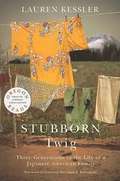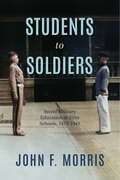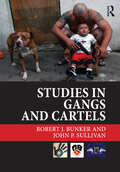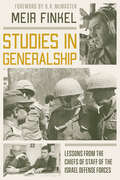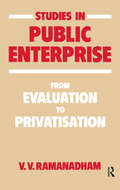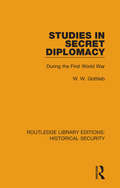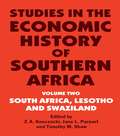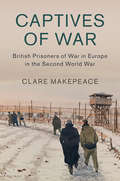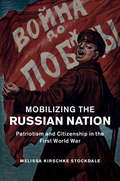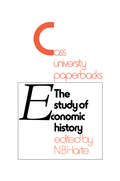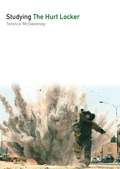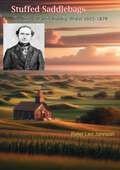- Table View
- List View
StuG III Brigade 191, 1940–1945: The Buffalo Brigade in Action in the Balkans, Greece and from Moscow to Kursk and Sevastopol
by Bruno BorkAn illustrated history of one brigade of German World War II armored fighting vehicles and the action they saw along the Eastern Front. Based on their experiences during the First World War, the Reichswehr decided that the infantry support gun of the future should be an armored, motorized vehicle with an effective caliber of cannon: the Sturmgeschütz III. The weapon was used in the &“fire brigade role&” at hotspots along the Front, where it was much feared by enemy forces. This illustrated volume tells the tale of Brigade 191, aka the &“Buffalo Brigade,&” who used the Sturmgeschütz III as they took part in Operation Barbarossa in the Ukraine, saw action during the fight for Greece in 1941 and were deployed to the areas of heaviest fighting in the campaign against the Soviet Union. This began with the infantry advance from Ukraine to Moscow (1941): then to Voronezh, Kursk, the Caucasus, and Kuban (1942), then the Kertsch Peninsula and the Crimea (1943-1944), before they were finally evacuated from Sevastopol into Romania by naval lighters. On the South-east Front (the retreat through the Balkans), the Brigade fought its way into Austria and was still fighting on the last day of the war to keep a corridor open. Keen to write an account recording the tactical significance of the Sturmgeschütz III, while surviving members of Brigade 191 also wished for a cohesive documentary record of the war, Bork set about gathering military records and literature, as well as interviewing as many ex-Brigade men as possible, in order to bring this detailed account into being.Praise for StuG III Brigade 191, 1940–1945 &“Author Bruno Bork not only offers a tactical unit history, but also another German &“blood and guts&” ground-level views of Hitler&’s retreats and defeats on the Eastern Front. This is also a truly riveting read.&” —ARGunners.com &“Upon finishing this book the reader will doubtlessly better realize what a useful and versatile armored fighting vehicle the Sturmgeschütz III really was to the German armed forces.&” —Globe at War &“As a unit history, the scenarios come a poppin on page after page.&” —Historical Miniatures Gaming Society &“Highly recommended for beginner to advanced builders and historians interested in the StuG actions on the Eastern Front.&” —AMPS
Stubborn Twig: Three Generations in the Life of a Japanese American Family
by Lauren KesslerStubborn Twig was selected by the Oregon Library Association as one of three books for "Oregon Reads", in early 2009. These books were chosen for the 150th state anniversary. The middle school book ("Bat 6", in the Bookshare collection), and this one (high school to adult) focus on the history of the Japanese Americans in Oregon. Stubborn Twig follows a well-known family through its life in Hood River valley and beyond. The WWII period includes the forced internment of all Japanese people on the west coast to inland relocation camps for the duration of the war. Stubborn Twig includes photos (captions are included with text), discussion group questions, and an index.
Student Resistance to Dictatorship in Chile, 1973-1990: 'Security to Study, Freedom to Live!' (Palgrave Studies in the History of Social Movements)
by Richard G. SmithThis book documents and analyses Chilean university and school students’ opposition to the Pinochet regime during the latter years of the 1970s and the 1980s. The book focuses on key episodes such as the establishment of cultural groups within the militarily controlled universities that enabled students to congregate and exchange ideas for the first time since the 1973 coup; how university and secondary school students created their own democratic institutions to challenge the regime-appointed bodies; and how these eventually led to the restoration of the national federations that had been banned by the military government. The author explores the key relationship between the vertically organised, underground political parties, and the horizontally organised, broad, non-partisan organisations created by the students, arguing that this structure brought advantages to the movement. The students’ contribution to the national protests in the 1980s ensured that opposition to the regime was highly visible in the city centre, resulting in a socially broadened opposition with a focus on youth, rather than disenfranchisement and poverty. Offering a detailed account of different forms of student activism, this book evaluates the role of school and university students within the broader anti-dictatorship opposition in Chile.
Students to Soldiers: Secret Military Education at Elite Schools, 1815–1945
by John F. MorrisAn expansive study of the brutal rites of initiation at elite institutions that shaped young men into military leaders Informed by his own experience as a cadet at West Point, John Morris offers the first transnational history of student life at elite military preparatory institutions in Europe and America and the unofficial, underground rituals, practices, and codes that formed a crucial part of the education there. Comparing British public schools, the monarchical cadet schools in Imperial Germany, Austria, and Russia, and the US Military Academy over the course of the nineteenth and into the twentieth century and the world wars, Morris presents critical insights on the unsanctioned methods employed to transform young students into leaders of men. Extracurricular traditions—including but not limited to severe hazing—Morris argues, shaped the officers-in-training much more than their official courses of study. He also shows how romantic and sexual relations between boys facilitated the cultivation of hypermasculinity at these institutions. Students to Soldiers offers a fascinating glimpse into the lives of the budding military elites of Europe and America, both unpacking the arcane rituals that eventually became codified into honored traditions and analyzing their influence over the long term.
Studies In The Napoleonic Wars
by Sir Charles William Chadwick Oman Kbe"These fascinating and valuable studies supplement Sir Charles Oman's major works about the Napoleonic Wars --Wellington's Army and the majestic seven-volume History of the Peninsular War.The subjects of study range widely and interestingly. They include a discussion of the views of historians from the time of Herodotus to the nineteenth century, and an account of the Secret Service which, as the author says in his Preface, illustrates "the underworld of political and military intrigue which escapes notice in general histories". Here, too, are Oman's seminal reflections on "Column and Line in the Peninsula". Along with his study of the Battle of Maida, also included in the book, this was the result of his investigation of British tactics before the Peninsular War, upon which he based his comprehension of Wellington's method of warfare. The discussion of Napoleon's use of cavalry draws from the whole period of the campaigns of 1800 to 1815, arising from the author's endeavours to discover the principles according to which Napoleon's generals handled cavalry during the Spanish War.The reappearance of these absorbing studies by one of the great masters of British military history will be warmly welcomed by specialist historians and general readers alike."-Print ed.
Studies in Environment and History: Waste into Weapons
by Peter ThorsheimDuring the Second World War, the United Kingdom faced severe shortages of essential raw materials. To keep its armaments factories running, the British government enlisted millions of people in efforts to recycle a wide range of materials for use in munitions production. Recycling not only supplied British munitions factories with much-needed raw materials - it also played a key role in the efforts of the British government to maintain the morale of its citizens, to secure billions of dollars in Lend-Lease aid from the United States, and to uncover foreign intelligence. However, Britain's wartime recycling campaign came at a cost: it consumed items that would never have been destroyed under normal circumstances, including significant parts of the nation's cultural heritage. Based on extensive archival research, Peter Thorsheim examines the relationship between armaments production, civil liberties, cultural preservation, and diplomacy, making Waste into Weapons the first in-depth history of twentieth-century recycling in Britain.
Studies in Gangs and Cartels
by Robert J. Bunker John P. SullivanConcerns over the changing nature of gangs and cartels and their relationships to states in the late 20th and early 21st centuries has resulted in the emergence of a scholarly body of work focused on their national security threat potentials. This body of work, utilizing the third generation gangs and third phase cartel typologies, represents an alternative to traditional gang and organized crime research and one that is increasingly influencing the US defense community. Rather than being viewed only as misguided youth and opportunistic criminals or, in their mature forms, as criminal organizations with no broader social or political agendas, more evolved gangs and cartels, are instead seen as developing political, mercenary, and state-challenging capacities. This evolutionary process has emerged due to the growing illicit economy and other unintended consequences of globalization.This important anthology of writings by Robert J. Bunker and John P. Sullivan draws upon a collection of their works from the mid-1990s to the present with the addition of new essays written specifically for this publication. The work will be of great interest to academics and students in the fields of political science and criminal justice and to military, law enforcement, and governmental professionals and policy makers.This book is a collection of new and previously published works from a variety of publications, a full list of which is on the Citation Information page.
Studies in Generalship: Lessons from the Chiefs of Staff of the Israel Defense Forces
by Meir FinkelThe commander, or chief of staff, of the Israel Defense Forces (IDF) is a prominent public figure in Israel. His decisions, advice, and persona are held in high regard by Israel's public and leadership, and have indirect impacts on social, economic, and foreign affairs. But until now, an in-depth study on the role and performance of the IDF's chiefs of staff has been sorely absent.In this study, Meir Finkel offers a robust and original comparative perspective on the IDF chiefs of staff throughout modern Israel's history, examining their conduct in six key areas: identifying change in the strategic environment, developing familiarity with all military domains, managing crises with wartime generals, rehabilitating the army after a botched war, leading a transformation in force design, and building relationships with the political echelon.The challenging and critical role of the chief of staff demands profound knowledge and authority in a vast and diverse range of fields. By providing a perspective that the IDF's known history has lacked until now, Finkel gives insights that may assist current and future high-rank leaders worldwide in carrying out their important work and offers lessons to students everywhere of strategy, military history, and military transformation.
Studies in Public Enterprise: From Evaluation to Privatisation (Routledge Library Editions: Public Enterprise And Privatization Ser.)
by V. V. RamanadhamFirst Published in 1987. Routledge is an imprint of Taylor & Francis, an informa company.
Studies in Secret Diplomacy: During the First World War (Routledge Libary Editions: Historical Security)
by W. W. GottliebOriginally published in 1957, the original blurb reads: ‘From these studies of the secret diplomacy surrounding the entry of Turkey and Italy into the First World War, emerges a picture of the complex machinery behind the obvious wheels of international politics. The activities of statesmen and diplomats are related to the ramifications of big business, banks, oil and armament companies. The story of each move and counter-move, told mostly in the actors’ own words and with many quotations from actual memoranda and dispatches, is based on sources which are quite new. The Russian collections of confidential correspondence, which include foreign diplomatic dispatches intercepted and deciphered in Russia, and the latest Documenti Diplomatici Italiani are practically unknown to the British public. This material has been integrated with that taken from all the available collections of British, French, German, Austro-Hungarian and American diplomatic documents, official publications, contemporary periodicals and economic and financial data, and such mines of information as the diaries, recollections and private letters of those involved. This unusual combination of source material allows some general conclusions to be drawn as to the laws and logic of the diplomacy of power politics. The most striking fact, perhaps, is the diplomatic war among allies. The book brings out the deep-seated conflicts of interests in the German-Austro-Hungarian coalition, and those dividing Britain, France, Russia and Italy in the Near East, the Balkans and the Mediterranean. Another point of special interest is the inter-group and party struggle inside the countries for or against war; and another is the genesis of some of the fateful Secret Treaties which bedevilled the peace settlements of 1919-20.’ Today it can be read and enjoyed in its historical context.
Studies in the Economic History of Southern Africa: Volume Two : South Africa, Lesotho and Swaziland
by Timothy M. Shaw Jane L. Parpart Z.A. KonczackiFirst Published in 1990. Volume Two of Studies of Economic History of South Africa, looks at the Lesotho and Swaziland regions. The unfolding history and historiography of Southern Africa pose profound challenges for both analysis and praxis in the last decade of the twentieth century. These challenges are reflected in the range of investigations and contradictions, some of which are treated here, which together constitute an intellectual and political conjuncture. This collection of studies deals with the countries which were not included in the companion book on the economic history of the Front- Line States. Most of the space in the present volume is devoted to South Africa, primarily because of its importance to the region but also because contributions to the economic history of that country in English are very extensive as compared to the other states of Southern Africa.
Studies in the Social and Cultural History of Modern Warfare: Allies in Memory
by Sam EdwardsAmidst the ruins of postwar Europe, and just as the Cold War dawned, many new memorials were dedicated to those Americans who had fought and fallen for freedom. Some of these monuments, plaques, stained-glass windows and other commemorative signposts were established by agents of the US government, partly in the service of transatlantic diplomacy; some were built by American veterans' groups mourning lost comrades; and some were provided by grateful and grieving European communities. As the war receded, Europe also became the site for other forms of American commemoration: from the sombre and solemn battlefield pilgrimages of veterans, to the political theatre of Presidents, to the production and consumption of commemorative souvenirs. With a specific focus on processes and practices in two distinct regions of Europe – Normandy and East Anglia – Sam Edwards tells a story of postwar Euro-American cultural contact, and of the acts of transatlantic commemoration that this bequeathed.
Studies in the Social and Cultural History of Modern Warfare: British Art and the First World War, 1914–1924
by James FoxThe First World War is usually believed to have had a catastrophic effect on British art, killing artists and movements, and creating a mood of belligerent philistinism around the nation. In this book, however, James Fox paints a very different picture of artistic life in wartime Britain. Drawing on a wide range of sources, he examines the cultural activities of largely forgotten individuals and institutions, as well as the press and the government, in order to shed new light on art's unusual role in a nation at war. He argues that the conflict's artistic consequences, though initially disruptive, were ultimately and enduringly productive. He reveals how the war effort helped forge a much closer relationship between the British public and their art - a relationship that informed the country's cultural agenda well into the 1920s.
Studies in the Social and Cultural History of Modern Warfare: British Prisoners of War in Europe in the Second World War (Studies in the Social and Cultural History of Modern Warfare #51)
by Clare MakepeaceThis is a pioneering history of the experience of captivity of British prisoners of war in Europe during the Second World War, focussing on how they coped and came to terms with wartime imprisonment. Clare Makepeace reveals the ways in which POWs psychologically responded to surrender, the camaraderie and individualism that dominated life in the camps, and how, in their imagination, they constantly breached the barbed wire perimeter to be with their loved ones at home. Through the diaries, letters and log books written by seventy-five POWs, along with psychiatric research and reports, she explores the mental strains that tore through POWs' minds and the challenges that they faced upon homecoming. The book tells the story of wartime imprisonment through the love, fears, fantasies, loneliness, frustration and guilt that these men felt, shedding new light on what the experience of captivity meant for these men both during the war and after their liberation.
Studies in the Social and Cultural History of Modern Warfare: British Prisoners of War in First World War Germany (Studies in the Social and Cultural History of Modern Warfare #49)
by Oliver WilkinsonOver 185,000 British military servicemen were captured by the Germans during the First World War and incarcerated as prisoners of war (POWs). In this original investigation into their experiences of captivity, Wilkinson uses official and private British source material to explore how these servicemen were challenged by, and responded to, their wartime fate. Examining the psychological anguish associated with captivity, and physical trials, such as the controlling camp spaces; harsh routines and regimes; the lack of material necessities; and, for many, forced labour demands, he asks if, how and with what effects British POWs were able to respond to such challenges. The culmination of this research reveals a range of coping strategies embracing resistance; leadership and organisation; networks of support; and links with 'home worlds'. British Prisoners of War offers an original insight into First World War captivity, the German POW camps, and the mentalities and perceptions of the British servicemen held within.
Studies in the Social and Cultural History of Modern Warfare: Memory and Migration in the Shadow of War
by Joy DamousiIn an engaging and original contribution to the field of memory studies, Joy Damousi considers the enduring impact of war on family memory in the Greek diaspora. Focusing on Australia's Greek immigrants in the aftermath of the Second World War and the Greek Civil War, the book explores the concept of remembrance within the larger context of migration to show how intergenerational experience of war and trauma transcend both place and nation. Drawing from the most recent research in memory, trauma and transnationalism, Memory and Migration in the Shadow of War deals with the continuities and discontinuities of war stories, assimilation in modern Australia, politics and activism, child migration and memories of mothers and children in war. Damousi sheds new light on aspects of forgotten memory and silence within families and communities, and in particular the ways in which past experience of violence and tragedy is both negotiated and processed.
Studies in the Social and Cultural History of Modern Warfare: Ordinary Workers, Vichy and the Holocaust
by Ludivine BrochShould French railwaymen during the Second World War be viewed as great resisters or collaborators in genocide? Ludivine Broch revisits histories of resistance, collaboration and deportation in Vichy France through the prism of the French railwaymen – the cheminots. De-sanctifying the idea of railwaymen as heroic saboteurs, Broch reveals the daily life of these workers who accommodated with the Vichy regime, cohabitated with the Germans and stole from their employer. Moreover, by intertwining the history of the working classes with Holocaust history, she highlights unexpected histories under Vichy and sensitive memories of the post-war period. Ultimately, this book bursts the myths of cheminot resistance and collaboration in the Holocaust, and reveals that there is more to their story than this. The cheminots fed both the French nation and the German military apparatus, exemplifying the complexities of personal, professional and political life under occupation.
Studies in the Social and Cultural History of Modern Warfare: Patriotism and Citizenship in the First World War
by Stockdale Melissa KirschkeThe First World War had a devastating impact on the Russian state, yet relatively little is known about the ways in which ordinary Russians experienced and viewed this conflict. Melissa Kirschke Stockdale presents the first comprehensive study of the Great War's influence on Russian notions of national identity and citizenship. Drawing on a vast array of sources, the book examines the patriotic and nationalist organizations which emerged during the war, the role of the Russian Orthodox Church, the press and the intelligentsia in mobilizing Russian society, the war's impact on the rights of citizens, and the new, democratized ideas of Russian nationhood which emerged both as a result of the war and of the 1917 revolution. Russia's war experience is revealed as a process that helped consolidate in the Russian population a sense of membership in a great national community, rather than being a test of patriotism which they failed.
Studies in the Social and Cultural History of Modern Warfare: Shell-Shock and Medical Culture in First World War Britain
by Tracey LoughranShell-Shock and Medical Culture in First World War Britain is a thought-provoking reassessment of medical responses to war-related psychological breakdown in the early twentieth century. Dr Loughran places shell-shock within the historical context of British psychological medicine to examine the intellectual resources doctors drew on as they struggled to make sense of nervous collapse. She reveals how medical approaches to shell-shock were formulated within an evolutionary framework which viewed mental breakdown as regression to a level characteristic of earlier stages of individual or racial development, but also ultimately resulted in greater understanding and acceptance of psychoanalytic approaches to human mind and behaviour. Through its demonstration of the crucial importance of concepts of mind-body relations, gender, willpower and instinct to the diagnosis of shell-shock, this book locates the disorder within a series of debates on human identity dating back to the Darwinian revolution and extending far beyond the medical sphere.
Studies in the Social and Cultural History of Modern Warfare: The First World War and German National Identity
by Jan VermeirenThe First World War and German National Identity is an original and carefully researched study of the coalition between Imperial Germany and Austria-Hungary during the First World War. Focusing on the attitudes taken by governmental circles, politically active groups, intellectuals, and the broader public towards the German-speaking population in the Habsburg Monarchy, Jan Vermeiren explores how the war challenged established notions of German national identity and history. In this context, he also sheds new light on key issues in the military and the diplomatic relationship between Berlin and Vienna, re-examining the German war aims debate and presenting many new insights into German-Hungarian and German-Slav relations in the period. The book is a major contribution to German and Central European history and will be of great interest to scholars of the First World War and the complex relationship between war and society.
Studies in the Social and Cultural History of Modern Warfare: The Great War, Museums, and Memory in Britain, Canada, and Australia (Studies in the Social and Cultural History of Modern Warfare #53)
by Jennifer WellingtonWhat does it mean to display war? Examining a range of different exhibitions in Britain, Canada and Australia, Jennifer Wellington reveals complex imperial dynamics in the ways these countries developed diverging understandings of the First World War, despite their cultural, political and institutional similarities. While in Britain a popular narrative developed of the conflict as a tragic rupture with the past, Australia and Canada came to see it as engendering national birth through violence. Narratives of the war's meaning were deliberately constructed by individuals and groups pursuing specific agendas: to win the war and immortalise it at the same time. Drawing on a range of documentary and visual material, this book analyses how narratives of mass violence changed over time. Emphasising the contingent development of national and imperial war museums, it illuminates the way they acted as spaces in which official, academic and popular representations of this violent past intersect.
Study Of The Leadership Displayed By Lieutenant General Thomas Jonathan Jackson During The American Civil War
by Major Perry C. Casto Jr.Confederate Lieutenant General Thomas J. Jackson is considered one of the greatest tacticians who ever lived. His Valley Campaign of 1862 is a classic example of the effective use of maneuver warfare. While much has been written about Jackson's tactics, very little attention has been paid to his leadership of the soldiers who executed his tactical plans. The United States Army's recent emphasis on maneuver warfare has stressed the importance of leadership in the conduct of such warfare. This study is an analysis of Jackson's military leadership as he commanded units from brigade to corps level in the Confederate Army of Northern Virginia to determine if he met the requirements of a good leader as those requirements are defined by current US Army doctrine. The study uses current Army doctrine as the basis to judge the effectiveness of Jackson as a leader. It discusses Jackson's background and its effect on the character of his leadership, the leadership that he displayed during the Civil War, and then compares his actions to current doctrine. The study concludes that while some of Jackson's actions deviated significantly from today's doctrinally sound leadership practices, in the aggregate his leadership was congruous with current doctrine and contributed to his success as a field commander.
Study of Economic History: Collected Inaugural Lectures 1893-1970
by N. B. HartePublished in the year 1975, Study of Economic History is a valuable contribution to the field of Military and Strategic Studies.
Studying The Hurt Locker (Studying Films)
by Terence McSweeneyIn this vibrant and dynamic book-length study drawing on a broad tapestry of research, Terence McSweeney offers an exploration of The Hurt Locker (2009), its stylistic and narrative devices, its cultural impact, its reception, and its relationship to the genre of the war film. McSweeney places the film in a richly textured historical, political, and industrial context, arguing that The Hurt Locker is part of a long tradition of films about American wars that play a considerable role in how audiences come to understand the conflicts that they depict. Thus, films about a nation’s wars are never “only a movie” but rather should be considered a cultural battleground themselves on which a war of representation is waged.
Stuffed Saddlebags: The Life of Martin Kundig, Priest 1805-1879
by Peter Leo JohnsonStuffed Saddlebags: The Life of Martin Kundig, Priest 1805-1879 is a biographical book written by Peter Leo Johnson. The book is a detailed account of the life of Martin Kundig, a Swiss Catholic priest who lived from 1805 to 1879. Kundig was a prominent figure in the Catholic Church and played a significant role in the religious and social history of Switzerland. The book provides a comprehensive overview of Kundig's life, from his childhood in Switzerland to his religious training and eventual ordination as a priest. The author delves into Kundig's experiences as a missionary in the United States and his work in establishing Catholic parishes and schools in the American Midwest. The book also explores Kundig's involvement in the political and social issues of his time, including his support for the abolition of slavery and his advocacy for the rights of immigrants. The author provides a detailed analysis of Kundig's writings and sermons, which reflect his commitment to social justice and his belief in the importance of education. Overall, Stuffed Saddlebags is a fascinating and insightful biography of a remarkable individual who played a significant role in the history of the Catholic Church and the United States. The book is well-researched and provides a rich and detailed portrait of Kundig's life, beliefs, and achievements. It is an excellent read for anyone interested in the history of the Catholic Church, American social history, or the life of a remarkable individual.-Print ed.

